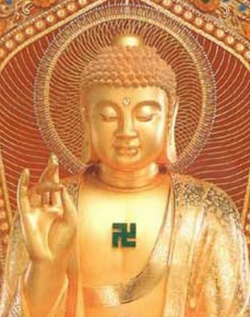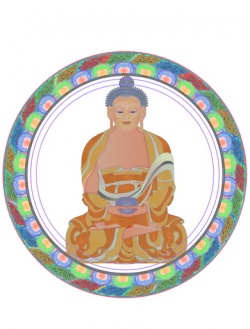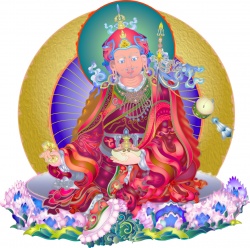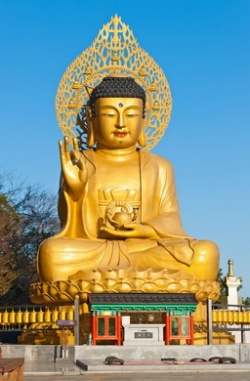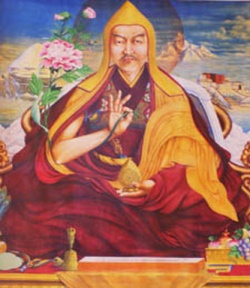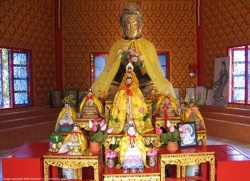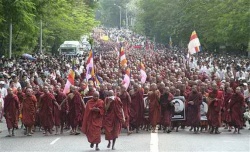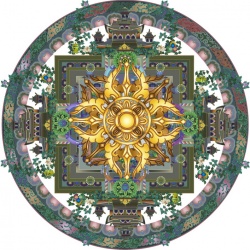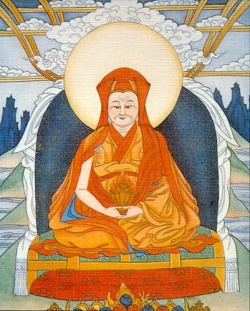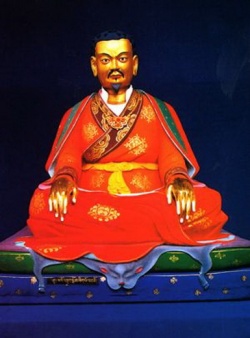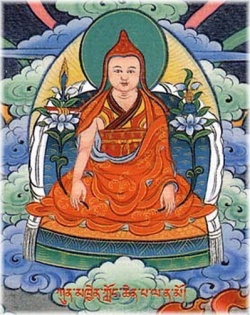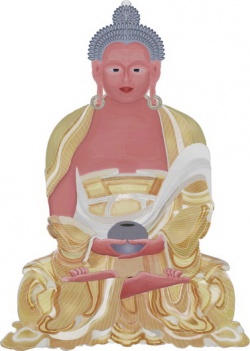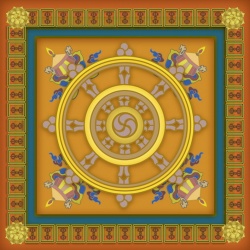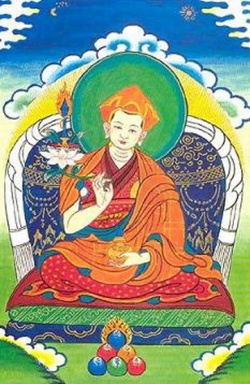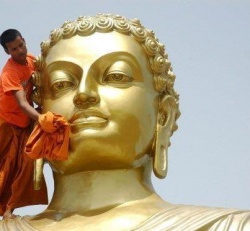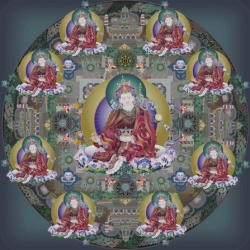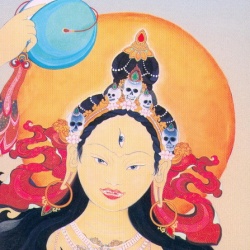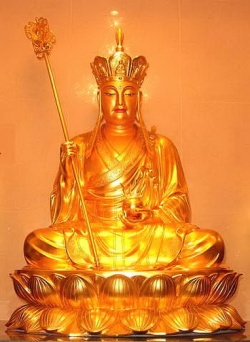The Laṅkāvatāra Sūtra by Daisetz Teitaro Suzuki: Introduction
The Laṅkāvatāra Sūtra
A Mahāyāna Text
Translated for the first time from
the original Sanskrit by
Daisetz Teitaro Suzuki
For those who have already read my Studies in the Laṅkāvatāra Sūtra[1], no special words are needed here. But to those who are not yet quite familiar with the teachings of Mahayana Buddhism an expository introduction to the principal theses of the Laṅkā may be welcome. Without something of preliminary knowledge as to what the Sutra proposes to teach, it will be difficult to comprehend the text intelligently. For thoughts of deep signification are presented in a most unsystematic manner. As I said in my Studies, the Laṅkā is a memorandum kept by a Mahayana master, in which he put down perhaps all the teachings of importance accepted by the Mahayana followers of his day. He apparently did not try to give them any order, and it is possible that the later redactors were not very careful in keeping faithfully whatever order there was in the beginning, thus giving the text a still more disorderly appearance. The introduction that follows may also serve as one to Mahayana Buddhism generally.
Contents
- 1 I
- 1.1 The Classification of Beings
- 1.2 The Buddha
- 1.3 The Buddha as Love
- 1.4 Skilful Means
- 1.5 One Buddha with Many Names
- 1.6 Transformation-bodies of the Buddha
- 1.7 The Bodhisattva and His Ten Vows
- 1.8 The Ignorant
- 1.9 The Turning back (parāvṛitti)
- 1.10 Self-discipline and the Buddha's Power
- 1.11 Buddha the Enlightened and Sarvasattva the Ignorant
- 2 II
- 3 =Ontology and the Twofold Egolessness
- 4 III
- 5 IV
- 6 Footnotes
- 7 Continue Reading
- 8 Source
I
The Classification of Beings
From the Mahayana point of view, beings are divisible into two heads: those that are enlightened and those that are ignorant. The former are called Buddhas including also Bodhisattvas, Arhats, and Pratyekabuddhas while the latter comprise all the rest of beings under the general designation of bāla or bālapṛithagjana—bala meaning "undeveloped", "puerile", or "ignorant", and pṛithagjana "people different" from the enlightened, that is, the multitudes, or people of ordinary type, whose minds are found engrossed in the pursuit of egotistic pleasures and unawakened to the meaning of life. This class is also known as Sarvasattva, "all beings" or sentient beings. The Buddha wants to help the ignorant, hence the Buddhist teaching and discipline.
The Buddha
All the Buddhist teachings unfold themselves around the conception of Buddhahood. When this is adequately grasped, Buddhist philosophy with all its complications and superadditions will become luminous. What is the Buddha?
According to Mahāmati the Bodhisattva-Mahāsattva, who is the interlocutor of the Buddha in the Laṅkā, the Buddha is endowed with transcendental knowledge (prajñā) and a great compassionate heart (karuṇā). With the former he realises that this world of particulars has no reality, is devoid of an ego-substance (anātman) and that in this sense it resembles Māyā or a visionary flower in the air. As thus it is above the category of being and non-being, it is declared to be pure (viśuddha) and absolute (vivikta) and free from conditions (animitta). But the Buddha's transcendental wisdom is not always abiding in this high altitude, because being instigated by an irresistible power which innerly pushes him back into a region of birth and death, he comes down among us and lives with us, who are ignorant and lost in the darkness of the passions (kleśa). Nirvana is not the ultimate abode of Buddhahood, nor is enlightenment. Love and compassion is what essentially constitutes the self-nature of the All-knowing One (sarvajña).
The Buddha as Love
The Buddha's love is not something ego-centered. It is a will-force which desires and acts in the realm of twofold egolessness, it is above the dualism of being and non-being, it rises from a heart of non-discrimination, it manifests itself in the conduct of purposelessness (anābhogacaryā). It is the Tathagata's great love (mahākaruṇā) of all beings, which never ceases until everyone of them is happily led to the final asylum of Nirvana; for he refuses as long as there is a single unsaved soul to enjoy the bliss of Samādhi to which he is entitled by his long spiritual discipline. The Tathagata is indeed the one who, endowed with a heart of all-embracing love and compassion, regards all beings as if they were his only child. If he himself enters into Nirvana, no work will be done in the world where discrimination (vtkalpa) goes on and multitudinousness (vicitratā) prevails. For this reason, he refuses to leave this world of relativity, all his thoughts are directed towards the ignorant and suffering masses of beings, for whom he is willing to sacrifice his enjoyment of absolute reality and self-absorption (samādhi-sukhabhūtakoṭyā vinivārya).
Skilful Means
The essential nature of love is to devise, to create, to accommodate itself to varying changing circumstances, and to this the Buddha's love is no exception. He is ever devising for the enlightenment and emancipation of all sentient beings. This is technically known as the working of Skilful Means (upāyakauśalya). Upāya is the outcome of Prajñā and Karuṇā. When Love worries itself over the destiny of the ignorant, Wisdom, so to speak, weaves a net of Skilful Means whereby to catch them up from the depths of the ocean called Birth-and-Death (samsāra). By Upāya thus the oneness of reality wherein the Buddha's enlightened mind abides transforms itself into the manifoldness of particular existences.
There is a gem known as Maṇi which is perfectly transparent and colourless in itself, and just because of this characteristic it reflects in it varieties of colours (vicitra-rūpa). In the same way the Buddha is conceived by beings; in the same way his teaching is interpreted by them; that is, each one recognises the Buddha and his teaching according to his disposition (āśaya), understanding (citta), prejudice (anuśaya), propensity (adhimukti), and circumstance (gati). Again, the Buddha treats his fellow-beings as an expert physician treats his patients suffering from various forms of illness. The ultimate aim is to cure them, but as ailments differ medicines and treatments cannot be the same. For this reason it is said that the Buddha speaks one language of enlightenment, which reverberates in the ears of his hearers in all possible sounds. Upāya may thus be considered in a way due to the infinite differentiation of individual characters rather than to the deliberate contrivance of transcendental wisdom on the part of the Buddha.
One Buddha with Many Names
All the Buddhas are of one essence, they are the same as far as their inner enlightenment, their Dharmakāya, and their being furnished with the thirty-two major and the eighty minor marks of excellence are concerned. But when they wish to train beings according to their characters, they assume varieties of forms appearing differently to different beings, and thus there are many titles and appellations of the Buddha as to be beyond calculation (asaṁkhyeya).
One noteworthy fact about this—the Buddha's assuming so many names, is that he is not only known in various personal names but also given a number of abstract titles such as No-birth, Emptiness, Suchness, Reality, Nirvana, Eternity, Sameness, Trueness, Cessation, etc. The Buddha is thus personal as well as metaphysical.
The Laṅkā here does not forget to add that though the Buddha is known by so many different names, he is thereby neither fattened nor emaciated, as he is like the moon in water neither immersed nor emerging. This simile is generally regarded as best describing the relation of unity and multiplicity, of one absolute reality and this world of names and forms.
Transformation-bodies of the Buddha
While the Trikāya dogma is not yet fully developed in the Laṅkā, each member of the trinity is treaceable in such ideas as Dharmatā-buddha, Vipāka-buddha, and Nirmāṇa-buddha. The notion of the transformation-body inevitably follows from the Buddha's desire to save the ignorant whose minds are not enlightened enough to see straightway into the essence of Buddhahood. As they are not clear-sighted, something is to be devised to lead them to the right path, and this something must be in accord with their mentalities. If not, they are sure to go astray farther and farther. If they are not capable of grasping Buddhatā as it is, let them have something of it and gradually be developed. The theory of Upāya (skilful means) is also the theory of Manomayakāya, will-body. As the incarnation of a great compassionate heart, the Buddha ought to be able to take any form he wishes when he sees the sufferings of sentient beings. The will-body is a part of the Buddha's plan of world-salvation. This is one of the reasons why Buddhism is often regarded as polytheistic and at the same time pantheistic.
The Bodhisattva and His Ten Vows
In Mahayana Buddhism the Buddha is not the only agent who is engaged in the work of enlightening or saving the world. While he is able to transform himself into as many forms as are required by sentient beings, he is also assisted by his followers or "sons" (putra, suta, or aurasa) as they are called in the Mahayana sutras. Bodhisattvas are thus the sons of the Buddha and apply themselves most arduously and most assiduously to the cause of Buddhism. In fact, the actual work of world-salvation, we can say, is carried on by these spiritual soldiers under the leadership of the Buddha. The latter is sometimes felt to be too remote, too serene, too superhuman, and his sight is often lost in the midst of our worldly struggles. But the Bodhisattva is always with us, and ever ready to be our confidant, for he is felt by us to share the same passions, impulses, and aspirations which are such great disturbing, though ennobling too, forces of our human life.
To state the truth, sentient beings are all Bodhisattvas, however ignorant and ready to err they may be. They are all Jinaputras, the sons of the Victorious, and harbour in themselves every possibility of attaining enlightenment. The Bodhisattvas who have gone up successively all the rungs of the Bhūmi ladder, and who are thus capable of extending their help over us, are really our own brethren. Therefore, Mahāmati of the Laṅkā opens his questions generally with this: "I and other Bodhisattvas, etc." Mahāmati is our mouthpiece voicing our wants and aspirations.
Thus is not the place to consider historically how the conception evolved in Buddhism whose primitive object seems to have consisted in the realisation of Arhatship. But we can state this that the essence of Bodhisattvahood is an unequivocal affirmation of the social, altruistic nature of humankind. Whatever enlightenment one gains, it must be shared by one's fellow-beings. This idea is classically expressed in the Mahayana by the so-called "Ten Vows of Samantabhadra". The Bodhisattva is a man of "inexhaustible vows (daśanishṭhāpāda). Without these he is not himself. To save the world, to bring all his fellow-beings up to the same level of thought and feeling where he himself is, and not to rest, not to enter into Nirvana until this is accomplished, how infinitely long and how inexpressively arduous the task may be. This is the Bodhisattva. Vowing to save all beings, which is technically known as Pūrva-praṇidhāna in Mahayana terminology, cannot even for a moment be separated from the life of the Bodhisattva.
The Buddha being surrounded by these noble-minded sons cannot fail finally to release all beings from the bondage of karma and ignorance and thirst for life. With this in view, he is always inspiring the Bodhisattvas with his sovereign power (prabhāva) and sustaining (adhishṭhāna) them in their efforts to bring enlightenment in the whole triple world.
The Ignorant
Life as it is lived by most of us is a painful business, for we have to endure much in various ways. Our desires are thwarted, our wishes are crushed, and the worst is that we do not know how to get out of this whirlpool of greed, anger, and infatuation. We are at the extreme end of existence opposed to that of the Buddha. How can we leap over the abyss and reach the other shore?
The Mahayana diagnosis of the conditions in which all sentient beings are placed is that they are all nursed by desire (tṛishṇā) as mother who is Accompanied by pleasure (nandī) and anger (rāga), while ignorance (avidyā) is father. To be cured of the disease, therefore, they must put an end to the continuous activities of this dualistic poisoning. When this is done, there is a state called emancipation (vimoksha) which is full of bliss. The Buddhist question is thus: "How is emancipation possible?" And here rises the Mahayana system of philosophy.
The Turning back (parāvṛitti)
To this philosophy, a special paragraph is devoted below. I wish here to say a few words concerning the important psychological event known as Parāvṛitti in the Laṅkā and other Mahayana literature. Parāvṛitti literally means "turning up" or "turning back" or "change"; technically, it is a spiritual change or transformation which takes place in the mind, especially suddenly, and I have called it "revulsion" in my Studies in the Laṅkāvatāra, which, it will be seen, somewhat corresponds to what is known as "conversion" among the psychological students of religion.
It is significant that the Mahayana has been insistent to urge its followers to experience this psychological transformation in their practical life. A mere intellectual understanding of the truth is not enough in the life of a Buddhist; the truth must be directly grasped, personally experienced, intuitively penetrated into; for then it will be distilled into life and determine its course.
This Parāvṛitti, according to the Laṅkā, takes place in the Ālaya-vijñāna or All-conserving Mind, which is assumed to exist behind our individual empirical consciousnesses. The Ālaya is a metaphysical entity, and no psychological analysis can reach it. What we ordinarily know as the Ālaya is its working through a relative mind The Mahayana calls this phase of the Ālaya tainted or defiled (klishṭa) and tells us to be cleansed of it in order to experience a Parāvṛitti for the attainment of ultimate reality.
Parāvṛitti in another sense, therefore, is purification (viśuddhi). In Buddhism terms of colouring are much used, and becoming pure, free from all pigment, means that the Ālaya is thoroughly washed off its dualistic accretion or outflow (āsrava), that is, that the Tathagata has effected his work of purification in the mind of a sentient being, which has so far failed to perceive its own oneness and allness. Being pure is to remain in its own selfhood or self-nature (svabhāva). While Parāvṛitti is psychological, it still retains its intellectual flavour as most Buddhist terms do.
Self-discipline and the Buddha's Power
As long as Parāvṛitt is an experience and not mere understanding, it is evident that self-discipline plays an important role in the Buddhist life. This is insisted upon in the Laṅkā as is illustrated in the use of such phrases as "Do not rely on others" (aparapraṇeya); "Strive yourselves" (śikshitavyam), etc. But at the same time we must not forget the fact that the Laṅkā also emphasises the necessity of the Buddha's power being added to the Bodhisattvas, in their upward course of spiritual development and in the accomplishment of their great task of world-salvation. If they were not thus so constantly sustained by the miraculous power of the Buddha, they would speedily fall into the group of the philosophers and Śrāvakas, and they would never be able to attain supreme enlightenment and preach the doctrine of universal emancipation. Indeed, when the Buddha so wishes, even such inanimate objects as mountains, woods, palaces, etc. will resound with the voice of the Buddha; how much more the Bodhisattvas who are his spiritual inheritors!
The doctrine of Adhishṭhāna gains all the more significance when we consider the development of Mahayana Buddhism into the doctrine of salvation by faith alone. The power of a Bodhisattva's original vows may also be judged as being derived from the Buddha. If the possibility of enlightenment is due to the Adhishṭhāna or Prabhāva of the Buddha, all the wonders that are to take place by the strength of the enlightenment must be inferred ultimately to issue from the fountain-head of Buddhahood itself.
At any rate the Mahayana idea of the Buddha being able to impart his power to others marks one of those epoch-making deviations which set off the Mahayana from so-called primitive or original Buddhism. When the Buddha comes to be considered capable of Adhishṭhāna, the next step his devotees are logically led to take would be the idea of vicarious suffering or atonement. Giving power to another is a positive idea while suffering for another may be said to be a negative one. Though this latter is strangely absent in the Laṅkā, the Gaṇḍavyūha as well as the Prajñāpāramitā are quite eloquent in elucidating the doctrine of vicarious suffering. According to this doctrine, whatever suffering one is enduring may be transferred on to another if the latter sincerely desires out of his unselfish and all-embracing love for others, to take these sufferings upon himself so that the real sufferers may not only be relieved of them but escape their evil consequences, thus enabling him to advance more easily and successfully towards the attainment of the blissful life. This goes quite against the idea of individual responsibility. But really religious minds require this vicarious suffering for their spiritual life.
To suffer or atone vicariously is still negative and fails to entirely satisfy our spiritual needs. The latter demand that more good must be done in order to suppress the evils which are found claiming this world for their own glorification. So the Mahayanists accumulate stocks of merit not only for the material of their own enlightenment but for the general cultivation of merit which can be shared equally by their fellow-beings, animate and inanimate. This is the true meaning of Pariṇāmana, that is, turning one's merit over to others for their spiritual interest.
As I said elsewhere, this notion of Pariṇāmana is not at all traceable in the Laṅkā, which is strange. The Laṅkā cannot be imagined to have been compiled prior to the Prajñāpāramitā, nor to the Gaṇḍavyūha or Avataṁsaka; if so, why this absence? How can this be explained?
Buddha the Enlightened and Sarvasattva the Ignorant
To conclude this section, Buddhism is the story of relationship between the two groups of beings: the one is called Buddha who is the enlightened, the Tathagata, the Arhat, and the other is generally designated as Sarvasattva, literally "all beings", who are ignorant, greedy for worldly things, and therefore in perpetual torment. In spite of their hankering for worldly enjoyments, they are conscious of their condition and not at all satisfied with it; when they reflect they find themselves quite forlorn inwardly, they long for real happiness, for ultimate reality, and blissful enlightenment. They look upwards, where the Buddha sits rapt in his meditation serenely regarding them with his transcendental wisdom. As he looks down at his fellow-beings inexplicably tormented with their greed and ignorance and egotism, he is disturbed, for he feels an inextinguishable feeling of love stirring within himself—the feeling now perfectly purified of all the defilements of selfishness, which embraces the whole world in pity though not attached to it. The Buddha leaves his transcendental abode. He is seen among sentient beings, each one of whom recognises him according to his own light.
Transcendental wisdom (prajñā) and a heart of all-embracing love (mahākaruṇā) constitute the very reason of Buddhahood, while the desire or thirst for life (tṛishṇa), and ignorance as to the meaning of life (avidyā), and deeds (karma) following from the blind assertion of life-impulse— these are the factors that enter into the nature of Sarvasattva, all ignorant and infatuated ones. The one who is above, looking downward, extends his arms to help; the other unable to extricate himself from entanglements looks up in despair, and finding the helping arms stretches his own to take hold of them. And from this scene the following narratives psychological, logical, and ontological, unfold themselves to the Buddhist soul.
II
Psychology
What may be termed Buddhist psychology in the Laṅkā consists in the analysis of mind, that is, in the classification of the Vijñānas. To understand thus the psychology of Buddhism properly the knowledge of these terms is necessary: citta, manas, vijñāna, manovijñāna, and ālayavijñāna.
To begin with Vijñāna. Vijñāna is composed of the prefix vi, meaning "to divide", and the root jñā which means "to perceive", "to know". Thus, Vijñāna is the faculty of distinguishing or discerning or judging. When an object is presented before the eye, it is perceived and judged as a red apple or a piece of white linen; the faculty of doing this is called eye-vijñāna.
In the same way, there are;
ear-vijñāna for sound,
nose-vijñāna for odour,
tongue-vijñāna for taste,
body-vijñāna for touch, and
for ideas—altogether six forms of Vijñāna for distinguishing the various aspects of world external or internal.
Of these six Vijñānas, the Manojivñāna is the most important as it is directly related to an inner faculty known as Manas. Manas roughly corresponds to mind as an organ of thought, but in fact it is more than that, for it is also a strong power of attaching itself to the result of thinking. The latter may even be considered subordinate to this power of attachment. The Manas first wills, then it discriminates to judge; to judge is to divide, and this dividing ends in viewing existence dualistically. Hence the Manas' tenacious attachment to the dualistic interpretation of existence. Willing and thinking are inextricably woven into the texture of Manas.
Citta comes from the root cit, "to think", but in the Laṅkā the derivation is made from the root ci, "to pile up", "to arrange in order". The Citta is thus a storehouse where the seeds of all thoughts and deeds are accumulated and stored up. The Citta, however, has a double sense, general and specific. When it is used in the general sense it means "mind", "mentation", "ideas", including the activities of Manas and Manovijñāna, and also of the Vijñānas; while specifically it is a synonym of Ālayavijñāna in its relative aspects, and distinguishable from all the rest of the mental faculties. When, however, it is used in the form of Citta-mātra, Mind-only, it acquires still another connotation. We can say that Citta appears here in its highest possible sense, for it is then neither simply mentation nor intellection, nor perception as a function of consciousness. It is identifiable with the Ālaya in its absolute aspect. This will become clearer later on.
Ālayavijñāna is ālaya+vijñāna, and ālaya is a store where things are hoarded for future use. The Citta as a cumulative faculty is thus identified with the Ālayavijñāna. Strictly speaking, the Ālaya is not a Vijñāna, has no discerning power in it; it indiscriminately harbours all that is poured into it through the channel of the Vijñānas. The Ālaya is perfectly neutral, indifferent, and does not offer to give judgments.
Relation Between the Various Functions
Having explained what the various important terms mean and what functions are indicated by them, let us proceed to see in what relationship they stand to one another. The whole system of mental functions is called in the Laṅkā Cittakalāpa or Vijñānakāya; Citta and Vijñāna are here used synonymously. In this mental system eight modes of activity are distinguished: Ālayavijñāna, Manas, Manovijñāna, and the five sense-Vijñānas. When these eight Vijñānas are grouped together under two general heads, the one group is known as Khyāti-Vijñāna (perceiving Vijñānas) and the other as Vastuprativikalpa-vijñāna (object-discriminating Vijñāna). But in fact the Vijñānas are not separable into these two groups, for perceiving is discriminating. When an individual object is perceived as such, that is, as solid, or as coloured, etc., discrimination has already taken place here; indeed without the latter, the former is impossible and conversely. Every Vijñāna performs these two functions simultaneously, which is to say, one functioning is analysable into two ideas, perceiving and discriminating. But it is to be observed that this double activity does not belong to the Ālayavijñāna.
Another way of classifying the Vijñānas is according to their Lakshaṇa or modes of being, of which three are distinguishable as evolving (pravṛitti), as performing deeds (karma), and as retaining their own original nature (jāti). From this viewpoint, all the Vijñānas are evolving and deed-performing Vijñānas except the Ālaya which always abides in its self-nature. For the Vijñānas may cease from evolving and performing deeds for some reason, but the Ālaya ever remains itself.
The Ālaya, according to the Laṅkā, has two aspects: the Ālaya as it is in itself, which is in the Sagāthakam called Pāramālaya-vijñāna, and the Ālaya as mental representation called Vijñaptir Ālaya. These two aspects are also known respectively as the Prabandha (incessant) and the Lakshaṇa (manifested). The Ālaya is incessant because of its uninterrupted existence; it is manifested because of its activity being perceptible by the mind.
From this, we can see that the Ālaya is conceived in the Laṅkā as being absolute in one respect and in the other as being subject to "evolution" (pravṛitti). It is this evolving aspect of the Ālaya that lends itself to the treacherous interpretation of Manas. As long as the Ālaya remains in and by itself, it is beyond the grasp of an individual, empirical consciousness, it is almost like Emptiness itself although it ever lies behind all the Vijñāna-activities, for the latter will cease working at once when the Ālaya is taken out of existence.
Manas is conscious of the presence behind itself of the Ālaya and also of the latter's uninterrupted working on the entire system of the Vijñānas. Reflecting on the Ālaya and imagining it to be an ego, Manas clings to it as if it were reality and disposes of the reports of the six Vijñānas accordingly. In other words, Manas is the individual will to live and the principle of discrimination. The notion of an ego-substance is herein established, and also the acceptance of a world external to itself and distinct from itself.
The six Vijñānas function, as it were, mechanically when the conditions are satisfied and are not conscious of their own doings. They have no intelligence outside their respective fields of activity. They are not organised in themselves and have no theory for their existence and Doings. What they experience is reported to the headquarters with no comment or interpretation. Manas sits at the headquarters and like a great general gathers up all the information coming from the six Vijñānas. - For it is he who shifts and arranges the reports and gives orders again to the reporters according to his own will and intelligence. The orders are then faithfully executed.
The Manas is a double-headed monster, the one face looks towards the Ālaya and the other towards the Vijñānas. He does not understand what the Ālaya really is. Discrimination being one of his fundamental functions, he sees multitudinousness there and clings to it as final. The clinging now binds him to a world of particulars. Thus, desire is mother, and ignorance is father, and this existence takes its rise. But the Manas is also a double-edged sword. When there takes place a "turning-back" (parāvṛitti) in it, the entire arrangement of things in the Vijñānakāya or Citta-kalāpa changes. With one swing of the sword the pluralities are cut asunder and the Ālaya is seen in its native form (svalakshaṇa), that is, as solitary reality (viviktadharma), which is from the first beyond discrimination. The Manas is not of course an independent worker, it is always depending on the Ālaya, without which it has no reason of being itself; but at the same time the Ālaya is also depending on the Manas. The Ālaya is absolutely one, but this oneness gains significance only when it is realised by the Manas and recognised as its own supporter (ālamba). This relationship is altogether too subtle to be perceived by ordinary minds that are found choked with defilements and false ideas since beginningless time.
The Manas backed by the Ālaya has been the seat of desire or thirst (tṛishṇā), karma, and ignorance. The seeds grow out of them, and are deposited in the Ālaya. When the waves are stirred up in the Ālaya-ocean by the wind of objectivity—so interpreted by the Manas—these seeds give a constant supply to the uninterrupted flow of the Vijñāna-waters. In this general turmoil in which we sentient beings are all living, the Ālaya is as responsible as the Manas; for if the Ālaya refused to take the seeds in that are sent up from the region of the Vijñāna, Manas may not have opportunities to exercise its two fundamental functions, willing and discriminating. But at the same time it is due to the Ālaya's self-purifying nature that there takes place a great catastrophe in it known as "turning-back". With this "turning-back" in the Ālaya, Manas so intimately in relation with it also experiences a transformation in its fundamental attitude towards the Vijñānas. The latter are no more regarded as reporters of an external world which is characterised with individuality and manifoldness. This position is now abandoned, the external world is no more adhered to as such, that is, as reality; for it is no more than a mere reflection of the Ālaya. The Ālaya has been looking at itself in the Manas' mirror. There has been from the very first nothing other than itself. Hence the doctrine of Mind-only (cittamātra), or the Ālaya-only.
The Religious Signification
The necessity of conceiving Ālaya in its double aspect, (1) as absolute reality (viviktadharma) and (2) as subject to causation (hetuka), comes from the Mahayana idea of Buddhahood (buddhatā). If Buddhahood is something absolutely solitary, all the efforts put forward by sentient beings to realise enlightenment would be of no avail whatever. In other words, all that the Tathagata wants to do for sentient beings would never have its opportunity to reach them. There must be something commonly shared by each so that when a note is struck at one end a corresponding one will answer at the other. The Ālaya is thus known on the one hand as Tathāgata-garbha, the womb of Tathagatahood, and on the other hand imagined by the ignorant as an ego-soul (pudgala or ātman).
The Tathāgata-garbha, therefore, whose psychological name is Ālayavijñāna, is a reservoir of things good and bad, pure and defiled. Expressed differently, the Tathāgata-garbha is originally, in its self-nature, immaculate, but because of its external dirt (āgantukleśa) it is soiled, and when soiled—which is the state generally found in all sentient beings—an intuitive penetration (pratyaksha) is impossible. When this is impossible as is the case with the philosophers and ignorant masses, the Garbha is believed sometimes to be a creator (karaṇa) and sometimes to be an ego-substance (ātman). As it is so believed, it allows itself to transmigrate through the six paths of existence. Let there be, however, an intuitive penetration into the primitive purity (prakṛitipuriśuddhi) of the Tathāgata-garbha, and the whole system of the Vijñānas goes through a revolution. If the Tathāgata-garbha or Ālaya-vijñāna were not a mysterious mixture of purity and defilement, good and evil, this abrupt transformation (parāvṛitti) of an entire personality would be an impossibility. That is to say, if the Garbha or the Ālaya while absolutely neutral and colourless in itself did not yet harbour in itself a certain irrationality, no sentient beings would ever be a Buddha, no enlightenment would be experienced by any human beings. Logicalness is to be transcended somewhere and somehow. And as this illogical-ness is practically possible, the Mahayana establishes the theory of Mind-only (cittamātra).
=Ontology and the Twofold Egolessness
In considering the theory of Mind-only, we have to be careful not to understand this term psychologically. Mind (citta) here does not mean our individual mind which is subject to the law of causation (hetupratyaya). Absolute Citta transcends the dualistic conception of existence, it belongs neither to the Vijñāna-system nor to our objective world (vishaya). Therefore, in the Laṅkā this Citta is frequently described in ontological terms.
The most significant one is Vastu, which is found coupled with Tathatā in one place (p. 147, line 6)) and with Ārya in another place (p. 164, lines 9 and 10). In the first case, Vastu and Tathatā are synonymously used; what is Tathatā, that is Vastu. Tathatā is to be rendered either "suchness", or "thatness", which is a term most frequently used in the Mahayana texts to designate the highest reality ever approachable by Prajñā, transcendental wisdom; Vastu in Buddhism is usually an individual object regarded as existing externally to the Vijñānas, and so is it in most cases in the Laṅkā also. But evidently in this connection where Vastu is Tathatā, it must mean the highest reality.
In the second case in which Ārya is affixed to Vastu, the ārya must be a modifier here, that is, this reality is something to be described as ārya, "noble", "holy", or "worthy".
The highest reality is also called "something that has been in existence since the very first" (pūrvadharmasthititā, p. 241, 1. 14), or (paurāṇasthitidharmatā, p. 143, ll. 5 and 9). As it is the most ancient reality, its realisation means returning to one's own original abode in which everything one sees around is an old familiar object. In Zen Buddhism, therefore, the experience is compared to the visiting one's native home and quietly getting settled (歸家穩坐, kuei-chia wen-tso). The Buddhas, enlightened ones, are all abiding here as gold is embedded in the mine. The ever-enduring reality (sthititā dharmatā) is above changes.
To be above changes means to remain in one's own abode, not to move away from it, and for this reason reality is known as "self-abiding" (svastha, p. 199, line 4), or "remaining in its own abode" (svasthāne 'vatishṭhate, p. 178, 1. 15).[2] To keep one's own abode it to be single, solitary, absolute: hence Reality is Viviktadharma, a thing of solitude; Bhūtakoṭi, limit of reality, which points to a similar mode of thinking. It is again Ekāgra, the summit of oneness, and this summit or limit (koṭi) is at the same time no-summit, no-limit, because this is gained only when one makes a final leap beyond the manifoldness of things.
The more ordinary expressions given to the highest reality known as Citta are Tathatā, "suchness" or "thusness", Satyatā, "the state of being true", Bhūtatā, "the state of being real", Dharmadhātu, "realm of truth", Nirvana, the Permanent (nitya), Sameness (samatā), the One (advaya), Cessation (nirodha), the Formless (animitta), Emptiness (śūnyatā), etc.
From these descriptions it is found natural for Mahayanists psychologically to deny the existence of an ego-soul or ego-substance in the Ālaya, and ontologically to insist that the tragedy of life comes from believing in the substantiality or finality of an individual object. The former is technically called the doctrine of Pudgalanairātmya, egolessness of persons,[3] and the latter that of Dharmanairātmya, egolessness of things; the one denies the reality of an ego-soul and the other the ultimacy of an individual object.
Superficially, this denial of an Ātman in persons and individual objects sounds negative and productive of no moral signification. But when one understands what is ultimately meant by Cittamātra (Mind-only) or by Vivikta-dharma (the Solitary), the negations are on the plane of relativity and intellection.
The term "the Middle" (madhyama), meaning "the Middle Way, does not occur in the Laṅkā proper except in its Sagāthakam portion. But the idea that the truth is not found in the dualistic way of interpreting existence, that it is beyond the category of being and non-being, is everywhere emphasised in the Laṅkā. In fact, we can say that one of the principal theses of the Laṅkā is to establish the Absolute which makes a world of particulars possible but which is not to be grasped by means of being and non-being (astinā-stitva). This Absolute is the Middle Way of the Madhyamaka school.
Unobtainability
This going beyond all forms of dualism, however differently it may be expressed, whether as being and non-being, or as oneness and manyness, or as this and that, or as causation and no-causation, or as form and no-form, or as assertion and negation, or as Saṁsāra and Nirvāṇa, or as ignorance and knowledge, or as work and no-work, or as good and evil, or as purity and defilement, or as ego and non-ego, or as worldly and super-worldly, ad infinitum —this going beyond a world of oppositions and contrasts constitutes one of the most significant thoughts of the Mahayana. There is nothing real as long as we remain entangled in the skein of relativity, and our sufferings will never come to an end. We must therefore endeavour to take hold of reality, but this reality is not something altogether solitary. For in this case no one of us will be able to have even a glimpse of it, and if we had, it will turn into something standing in opposition to this world of relativity, which means the loss of solitariness, that is, the solitary now forms part of this world.
Thus, according to Buddhist philosophy, reality must be grasped in this world and by this world, for it is that "Beyond which is also Within". The Laṅkā compares it to the moon in water or a flower in a mirror. It is within and yet outside, it is outside and yet within. This aspect of reality is described as "unobtainable" or "unattainable" (anupalabdha). And just because it is unobtainable in a world of particulars, the latter from the point of view of reality is like a dream, like a mirage, and so on. The subtlest relation of reality to the world is beyond description, it yields its secrets only to him who has actually realised it in himself by means of noble wisdom (āryajñāna or prajñā). This realisation is also a kind of knowledge though different from what is generally known by this name.
Epistemology
Without a theory of cognition, therefore, Mahayana philosophy becomes incomprehensible. The Laṅkā is quite explicit in assuming two forms of knowledge: the one for grasping the absolute or entering into the realm of Mind-only, and the other for understanding existence in its dualistic aspect in which logic prevails and the Vijñānas are active. The latter is designated Discrimination (vikalpa) in the Laṅkā and the former transcendental wisdom or knowledge (prajñā). To distinguish these two forms of knowledge is most essential in Buddhist philosophy.
The Laṅkā is decidedly partial to the use of Āryajñāna instead of Prajñā, although the latter has been in use since the early days of Buddhism. Āryajñāna, noble wisdom, is generally coupled with Pratyātma, inner self, showing that this noble, supreme wisdom is a mental function operating in the depths of our being. As it is concerned with the highest reality or the ultimate truth of things, it is no superficial knowledge dealing with particular objects and their relations. It is an intuitive understanding which, penetrating through the surface of existence, sees into that which is the reason of everything logically and ontologically.
The Laṅkā is never tired of impressing upon its readers the importance of this understanding in the attainment of spiritual freedom; for this understanding is a fundamental intuition into the truth of Mind-only and constitutes the Buddhist enlightenment with which truly starts the religious life of a Bodhisattva.
This transcendental Jñāna is variously designated in the Laṅkā. It is Pravicayabuddhi, that is, an insight fixed upon the ultimate ground of existence. It is Svabuddhi, innate in oneself; Nirābhāsa, or Anābhāsa (imagelessness), beyond all forms of tangibility; Nirvikalpa, beyond discrimination, meaning direct empirical knowledge before analysis starts in any form whatever; which therefore is not at all expressible by means of words (vāc or ruta). The awaking of supreme knowledge (anuttarasamyaksaṁbodhi) is the theme of the Prajñāpārṇmitā-sūtras, but in the Laṅkā the weight of the discourse is placed upon the realisation by means of Āryajñāna of ultimate reality which is Mind-only. This psychological emphasis so distinctive of the Laṅkā makes this sutra occupy a unique position in Mahayana literature.
The knowledge that stands contrasted to Prajñā or Āryajñāna is Vikalpabuddhi, or simply Vikalpa, which I have translated "discrimination". It is relative knowledge working on the plane of dualism, it may be called the principle of dichotomy, whereby judgment is made possible. By us existence is always divided into pairs of conception, thesis and antithesis, that is, being and non-being, permanent and impermanent, Nirvana and Samsara, birth and death, creating and created, this and that, Me and not-Me, ad libitum. This is due to the working of Vikalpa. The Lakshaṇa (form) of existence thus presented to us is not its real nature, it is our own thought-construction (vijñapti); but our Buddhi which seeks after pluralities fails to understand this fact and makes us cling to appearances as realities. As the result, the world in which we now find ourselves living ceases to be what it is in itself; for it is one we have constructed according to our own ignorance and discrimination. Reality escapes us, truth slips off our grasp, false views accumulate, wrong judgments go on adding complexities upon complexities. The habit-energy (vāsanā) thus created takes complete hold on the Ālayavijñāna, and Ālaya the Absolute is forever unable to extricate itself from these encumbrances. Eternal transmigration to no purpose must be our destiny.
The Twofold Truth (satya)
The distinction between the highest truth (paramārtha-satya) and conventional truth (samvṛiti-satya) is not explicitly held in the Laṅkā, but allusions are occasionally made to them; and it is said that false discrimination belongs to conventionalism (p. 131, 1. 3). Another word for conventionalism is Vyavahāra, worldly experience, according to which we talk of things being born and destroyed, and also of the how, what, where, etc. of existence. This kind of knowledge does not help us to have an insight into the depths of being.
The Three Svabhāvas
Another way of classifying knowledge is known as three Svabhāvas in the Laṅkā. This is a generally recognised classification in all the schools of Mahayana Buddhism. Svabhāva means "self-nature" or "self-reality" or "self-substance , the existence of which in some form is popularly accepted. The first form of knowledge by which the reality of things is assumed is called Parikalpita, "imagined", that is, imagination in its ordinary sense. This is an illusion, for things are imagined to exist really where in fact there are none. It is like seeing a mirage which vanishes as one approaches. Imagined (parikalpita) objects have, therefore, no objective reality.
The second form of knowledge by which we examine existence is Paratantra, "depending upon another". This is a kind of scientific knowledge based on analysis. Buddhists make use of this knowledge to disprove the substantiality of individual objects, that is, the svabhāvatva of things. According to them, there is nothing self-existing in the world, everything is depending for its existence on something else, things are universally mutually conditioned, endlessly related to one another. Dissect an object considered final, and it dissolves itself into airy nothingness. Modern scientists declare that existence is no more than mathematical formulae. The Mahayanists would say that there is no Svabhāva in anything appealing as such to the Vijñānas when it is examined from the Paratantra point of view.
The imagined view (parikalpita) of reality does not give us a true knowledge of it, and the relativity view (paratantra) reduces it into nothingness: if so, where does our boat of enlightenment get anchored? The Laṅkā tells us that there is a third way of viewing existence, called Parinishpanna, "perfected", which allows us to become truly acquainted with reality as it is. It is this "perfected" knowledge whereby we are enabled to see really into the nature of existence, to perceive rightly what is meant by Svabhāva, and to declare that there is no Svabhāva as is imagined by the ignorant and that all is empty (śūnya).
Perfect or "perfected" knowledge issues from Prajñā, or Āryajñāna, or sometimes simply Jñāna, seeing into the suchness of things. It perceives things as they are, because going beyond the realm of being and non-being which belongs to discrimination, the principle of dichotomisation, it dives into the abyss where there are no shadows (anābhāsa). This is called self-realisation (svasiddhi). So states the Laṅkā that as the wise see reality with their eye of Prajñā, they ascertain definitely what it is, i. e. in its self-nature (bhāvasvabhāva) and not as is seen by the ignorant whose eye is never raised beyond the horizon of relativity.
This is again called seeing into the emptiness of things. Emptiness (śūnyatā), however, does not mean "relativity", as is thought by some scholars. Relativity-emptiness is on the lower plane of knowledge and does not reveal the real view of existence as it is. Emptiness taught in the Mahayana texts goes far deeper into the matter. It is the object of transcendental knowledge. As long as one stays in the world of relativity where logic rules supreme, one cannot have even the remotest idea of true emptiness or what is designated in the Prajñāpāramitā as Mahāśūnyatā. The Laṅkā has also this kind of Śūnyatā mentioned as one of the seven Emptinesses (p. 94). Relativity-emptiness so called corresponds to the first of the seven Emptinesses, while the Mahayana Śūnyatā is Paramārtha-āryajñāna-mahāśūnyatā, that is, the great void of noble wisdom which is the highest reality.
The Five Dharmas
Before concluding this section, we must not forget to mention what is known as the Five Dharmas in the Laṅkā making up one of the main topics of discourses. The Five Dharmas and the Three Svabhāvas are different ways of classifying the same material. The Five are: Appearances (nimitta), Names (nāma), Discrimination (saṁkalpa), Right Knowledge (samyagjñāna), and Suchness (tathatā). The first three correspond to the two of the Three Svabhāvas, Parikalpita and Paratantra, while the last two belong to the Parinishpanna.
Our relative knowledge starts with perceiving Appearances to which Names are given. Names are then thought real and discrimination is carried on. We can say that discrimination has been with us from the first even when what is called perception has not taken place. For naming is impossible without some form of discrimination. Then the worst thing comes upon us as we begin to persuade ourselves and think that by giving Names existence has been successfully disposed of, and feel comfortable about the problems of religion. Although without naming no knowledge is possible, Right Knowledge (samyagjñāna) is not to be had here. For this is the inexpressible, the unnamable, it is the meaning (artha) not to be grasped by words. In this the Laṅkā permits no equivocation, it most emphatically advises us not to attach ourselves to words.
The object of Right Knowledge is Suchness of things as not conditioned by the category of being and non-being. It is in this sense that ultimate reality is said to be like the moon in the water, it is not immersed in it, nor is it outside it. We cannot say that the moon is in water, for it is a mere reflection; but we cannot say that it is not there, for a reflection though it may be it is really before us. Plurality of objects is not real from the point of view of relativity as well as from the point of view of Suchness. If some one declares such reality as maintained by the Mahayana is too ethereal, too phantom-like, too unreal for our religious aspirations, the Laṅkā will immediately retort, "You are still on the plane of relativity." When the Āryajñāna is awakened, Tathatā is the most real thing and a term most fittingly applied as far as our power of designation is concerned.
III
The Message of the Laṅkā
There are many other thoughts of interest in the Laṅkā which may be discussed in this Introduction. But as I have already given up many pages to it and as the reader who wishes to know more about the Sutra may go to my Studies in the Laṅkāvatāra, I will say just a few words about the position of this Sutra among the general Mahayana Buddhist texts.
While we are still in the dark as to how Mahayana Buddhism developed in India, we know that when it was introduced into China by the missionaries from India and central Asia, it was already regarded as directly coming from the Buddha's own golden mouth, and that what must have developed during several hundred years after his death was taken in a wholesale manner for a system fully matured in his life-time extending over a period of about half a century after his Enlightenment. As the sutras were translated into Chinese, the first of which appeared in 68 a. d., they profoundly stirred the Chinese and then the Japanese mind awakening their religious consciousness to its very depths. The following are the most important Mahayana texts that thus served to move the religious feelings of the Far-eastern peoples and are still continuing to do so.
(1) The Saddharma-puṇḍarīka-sūtra. One of the main theses of this inspiring scripture is the announcement that the Buddha never died, that he is forever living on the Mount of the Holy Vulture and preaching to a group of the Śrāvakas, Pratyekabuddhas, and Bodhisattvas, who are no less beings than ourselves, and that the Buddha has just one vehicle (yāna) for all beings. This must have been a revolutionary teaching at the time when the Buddha was thought to be just as transient and mortal as ourselves, and when the only thing that was left behind after his Nirvana was his Dharma, in which his followers were asked to find their Master.
(2) The Avalokiteśvara-vikurvaṇa-nirdeśa. This is commonly known as Kwannon-gyo in Japan and forms the twenty-fourth chapter of the Sanskrit Saddharma-puṇḍarīka, but it will be better to treat it as a separate document as it has quite an independent message and has been so considered though not always consciously by its devotees. Avalokiteśvara is here represented as a god of mercy who will help anybody who finds himself in trouble spiritually as well as materially. In popular minds the god is no more masculine than feminine; if anything, more feminine, because of mercy being more reality associated with eternal femininity. That he can assume various forms (vikurvaṇa) in order to achieve his ends appeals very much to the religious imagination of the Eastern peoples. And this doctrine of transformation is one of the characteristic features of Mahayana Buddhism.
(3) The Avataṁsaka-sūtra. This is an encyclopedic sutra of which we find the Gaṇḍavyūha and the Deśabhūmika forming a part. It is another Mahayana sutra that has influenced the Chinese and the Japanese mind profoundly. The so-called Interpenetration which constitutes the central thought of the sutra is symbolically and effectively treated in the Chinese translations by Buddhabhadra (60 fas.), by Śikshānanda (80 fas.), and by Prajñā (40 fas.). The sutra as we have it now contains many sutras which may be considered independent though they no doubt belong to the same class of literature. The reading may be tedious from the modern point of view as the main theme is not so succinctly presented, and it takes some time before the reader can get into the mood of the sutra itself. After a quiet and patient pursuit of the text, however, he cannot help but be deeply impressed with its underlying spirit whose grandeur of outlook almost surpasses human comprehension. The huge rock-cut figure of Vairocana at Lung-men and the bronze figure in Nara are respectively the Chinese and the Japanese artistic response to the spiritual stimulation caused by the [[Avataṁsaka, or the Gaṇḍavyūha which is the same thing.
Another profound effect produced by this sutra on the Eastern mind is the conception of the Bodhisattva Samantabhadra with his "ten inexhaustible vows." He would not enter into Nirvana, that coveted object of all the Buddhists, because he would not have one single soul unsaved behind him. And by this "soul" was meant not only human soul but the soul of every being animate or inanimate. It was the vow of Samantabhadra to release animals, plants, and even such inanimate existences as mountains, waters, earths, etc., from the bondage of ignorance and karma. His universe, moreover, was far wider and more spiritualistic than our ordinary one
(4) The Prajnā-pāramitā-sūtra. This is regarded by most Mahayana scholars to have been one of the first Mahayana literature that was declared against the hair-splitting scholastic philosophy of early Buddhist doctors, gives us the doctrine of Emptiness or Void (śūnyatā), whereby every possible straw of attachment is taken away from us. To be left alone in the Void, even with this Void vanishing from around us, is the method of perfect emancipation proposed by the Prajñā-pāramitā. This was quite a direct straightforward proposition on the part of the Mahayanist. It appealed greatly to intellectual minds as well as the mystical. While the Avataṁsaka filled the universe with things of imagination even to its minutest particle, the Prajñā-pāramitā swept everything away from the universe which now becomes a vast Void indeed. And in six hundred fascicles of the sutra we are warned not to be afraid of, not to be taken aback by this vast Void. If we stagger at this gospel of absolute Emptiness, we are told by the Buddha that we cannot be good followers of the Mahayana.
(5) The Vimalakīrti-sūtra. This is a masterpiece, a drama with great literary merit, and because of this fact it is read more generally than other Buddhist sutras by the laity. The signification of this sutra lies in taking our soiled coat of attachment off our back which we have been wearing ever since we became aware of an external existence. Another significant feature of the sutra is that its chief figure of interest is not the Buddha but a wealthy layman called Vimalakīrti. It is this crafty old gentleman-philosopher who puts to shame all the Śrāvakas and Bodhisattvas coming to argue with him about the deepest truths of Buddhism, except Mañjuśrī, the head of the Bodhisattvas. The latter proved a good match for the eloquence of the lay-disciple of the Buddha. What we have to notice especially in this Mahayana text is that Buddhism does not require us to lead a homeless life as a Bhikshu in order to attain enlightenment, that is, the householder's life is as good and pure as the mendicant's.
(6) In this respect the Śrimālā-sūtra is also significant, for Śrimālā the queen inspired by the wisdom and power of the Buddha delivers a great sermon on the Tathāgata-garbha. The Mahayana may be said to be the revolt of laymen and laywomen against the ascetic spirit of exclusion pervading among early advocates of Buddhism.
(7) The Sukhāvatī-vyūha-sūtra. The influence of this sutra on Oriental people is quite different from that of the other sutras, for it has awakened the faith-aspect of their religious consciousness, which is established on the general basis of Mahayana philosophy. Superficially, the faith of Amitābha looks very much like Christian faith in Christ, but the underlying thoughts are not at all the same. The Jodo school could not take its rise from any other soil than Mahayana Buddhism. In Japan this school has achieved a unique development marking a spiritual epoch in the history of religious faith in the East.
(8) The Parinirvāṇa-sūtra. This once formed the foundation of the Nirvana school in the early history of Chinese Buddhism. Its main assertion is that the Buddha-nature is present in every one of us. Before the arrival of this sutra in China it was generally believed that there was a class of people known as Icchanti who had no Buddha-nature in them and therefore who were eternally barred from attaining enlightenment. This belief was entirely expelled, however, when a statement to the contrary was found in the sutra, saying that "There is something in all beings which is true, real, eternal, self-governing, and forever unchanging—this is called Ego, though quite different from what is generally known as such by the philosophers. This Ego is the Tathāgata-garbha, Buddha-nature, which exists in every one of us, and is characterised with such virtues as permanency, bliss, freedom, and purity."
(9) All these and other sutras of Mahayana Buddhism may seem to exhaust the many-sided aspects of this school, but another is needed to tell us that mere understanding is not enough in the Buddhist life, that without self-realisation all intellection amounts to nothing. To tell us this is the office of the Laṅkāvatāra-sūtra, and Bodhidharma, father of Zen Buddhism, made use of the text quite effectively; for it was through him that a special school of Buddhism under the title of Zen or Ch'an has come to develop in China and in Japan. While Zen as we have it now is not the same in many respects as Bodhidharma first proclaimed it about fifteen centuries ago, the spirit itself flows quite unchanged in the East. And this is eloquently embodied in the Laṅkāvatāra-sūtra. It is not, however, necessary here for us to enter into details, for the point has been fully dwelt upon in my recent work, Studies in the Laṅkāvatāra Sūtra. Suffice it to touch lightly upon the characteristic features of the Sutra, which constitute its special message as distinguished from the other sutras already referred to.
There is no doubt that the Laṅkā is closely connected in time as well as in doctrine with The Awakening of Faith in the Mahāyāna generally ascribed to Aśvaghosha. While he may not have been the author of this most important treatise of Mahayana philosophy, there was surely a great Buddhist mind, who, inspired by the same spirit which pervades the Laṅkā, the Avataṁsaka, the Parinirvāṇa, etc., poured out his thoughts in The Awakening. Some scholars contend that The Awakening is a Chinese work, but this is not well grounded.
In a way The Awakening is an attempt to systematise the Laṅkā, for all the principal teachings of the latter are found there developed in due order. As far as the theoretical side is concerned, both teach the existence of the Garbha as ultimate reality. While this lies in ordinary people defiled by the evil passions and does not shine out in its native purity, we cannot deny its existence in them. When the external wrappage of impurities is peeled off we all become Buddhas and Tathagatas. In fact, the birth of a Tathagata is nowhere else than in this Garbha.
The Garbha is from the psychological point of view the Ālayavijñāna, all-conserving mind, in which good and bad are mingled, and the work of the Yogin, that is, one who seeks the truth by means of self-discipline, is to separate the one from the other. Why is the Ālaya found contaminated by evil thoughts and desires? What is the evil? How does it come out in this world? How is the truth to be realised? These questions are answered by postulating a system of Vijñānas and by the doctrine of Discrimination (vikalpa), as has already been expounded above.
This is the point where the Laṅkā comes in contact with the Yogācāra school. The Yogācāra is essentially psychological standing in contrast in this respect to the Madhyamaka school which is epistemological. But the Ālayavijñāna of the Yogācāra is not the same as that of Laṅkā and the Awakening of Faith. The former conceives the Ālaya to be purity itself with nothing defiled in it whereas the Laṅkā and the Awakening make it the cause of purity and defilement. Further, the Yogācāra upholds the theory of Vijñaptimātra and not that of Cittamātra, which belongs to the Laṅkā, Avataṁsaka, and Awakening of Faith. The difference is this: According to the Vijñaptimātra, the world is nothing but ideas, there are no realities behind them; but the Cittamātra states that there is nothing but Citta, Mind, in the world and that the world is the objectification of Mind. The one is pure idealism and the other idealistic realism.
To realise the Cittamātra is the object of the Laṅkā, and this is done when Discrimination is discarded, that is, when a state of non-discrimination is attained in one's spiritual life. Discrimination is a logical term and belongs to the intellect. Thus we see that the end of the religious discipline is to go beyond intellectualism, for to discriminate, to divide, is the function of the intellect. Logic does not lead one to self-realisation. Hence Nāgārjuna's hair-splitting dialectics. His idea is to prove the ineffectiveness of logic in the domain of our spiritual life. This is where the Laṅkā joins hands with the Madhyamaka. The doctrine of the Void is indeed the foundation of Mahayana philosophy. But this is not to be understood in the manner of analytical reasoning. The Laṅkā is quite explicit and not to be mistaken in this respect.
So far, the Laṅkā may seem to be only a philosophical treatise with nothing religious in it, but the fact is that the Sutra is deeply tinged with religious sentiments. For instance, the Bodhisattva would not enter into Nirvana because of his vows to save all sentient beings, and his vows are not limited in time and space, and for this reason they are called "inexhaustible". Not only are his vows inexhaustible but the "skilful means" he uses for the emancipation of all beings know no limits. He knows how to make the best use of his inexhaustible resources intellectual and practical for this single purpose. Here we may say that the Bodhisattva Samantabhadra of the Avataṁsaka or the Gaṇḍavyūha is reflected.
In the Laṅkā all the most fundamental conceptions of the Mahayana are thrown in without any attempt on the part of the compiler or compilers to give them a system. This is left to the thoughtful reader himself who will pick them up from the medley and string them into a garland of pearls out of his own religious experience.
The one significant Mahayana thought, however, which is not expressly touched upon in the Sutra is that of Pariṇāmana. Pariṇāmana means to turn one's merit over to somebody else so as to expedite the latter's attainment of Nirvana. If anybody does anything good, its merit is sure to come back to the doer himself—this is the doctrine of Karma; but according to the Mahayana the recipient need not always be the doer himself, he may be anybody, he may be the whole world; merit being of universal character can be transferred upon anything the doer wishes. This transferability is known as the doctrine of Pariṇāmana, the turning over of one's good work to somebody else. This idea comes from the philosophical teaching of Interpenetration as upheld in the Avataṁsaka.
IV
The Date of the Laṅkā
As is the case with other Buddhist texts it is quite impossible with our present knowledge of Indian history to decide the age of the Laṅkā. The one thing that is certain is that it was compiled before 443 a. d. when the first Chinese translation is reported to have been attempted. But this does not mean that the whole text as we have it now was then already in existence, for we know that the later translations done in 513 and 700-704 contain the Dhāraṇī and the Sagāthakam section which are missing in the 443 one (Sung). Further, the Meat-eating chapter also suffered certain modifications, especially in the 513 (Wei) one.
Even with the text that was in existence before 443 a. d. we do not know how it developed, for it was not surely written from the beginning as one complete piece of work as we write a book in these modern days. Some parts of it must be older than others, since there is no doubt that it has many layers of added passages.
To a certain extent, the contents may give a clue to the age of the text, but because of the difficulty of separating one part from another from the point of view of textual criticism, arguments from the contents as to the date are of very doubtful character. As long as we have practically no knowledge of historical circumstances in which the Buddhist texts were produced one after another in India or somewhere else, all the statements are more or less of the character of an ingenious surmise. All that we can say is this that the Laṅkā is not a discourse directly given by the founder of Buddhism, that it is a later composition than the Nikāyas or Āgamas which also developed some time after the Buddha, that when Mahayana thoughts began to crystallise in the Northern as well as in the Southern part of India probably about the Christian era or even earlier, the compiler or compilers began to collect passages as he or they came across in their study of the Mahayana, which finally resulted in the Buddhist text now known under the title of Laṅkāvatāra-sūtra.
Some Remarks Concerning the Text
Certain irregularities of the chapter-endings are to be noticed in this connection. Generally these endings show that the chapters are composite parts of a sutra and belong to it; but in the case of the Laṅkā some endings are quite of an independent character, and their relation to the text is not at all definite. For instance:
Chapter I—"Chapter One Known as Rāvaṇa-invitation";
Chapter II—"Here Ends Chapter Two Known as the Collection of All the Dharmas in the 36, 000 (śloka) Laṅkāvatāra";
Chapter III—"Here Ends Chapter Three on Impermanency in the Laṅkāvatāra, a Mahāyāna Sūtra";
Chapter IV—"Here Ends Chapter Four on Realisation";
Chapter V—"Here Ends Chapter Five on the Permamency and Impermanency of the Tathagata";
Chapter VI—"Here Ends Chapter Six on Momentariness";
Chapter VII—"Here Ends Chapter Seven on Egolessness";
Chapter VIII—"Here Ends Chapter Eight on Meat-eating from the Laṅkāvatāra which is the Essence of All the Buddha-Teachings";
Chapter IX—"Here Ends Chapter Nine Known as Dhāraṇī in the Laṅkāvatāra."
These irregularities, at least in one case, show that there was a larger Laṅkā containing 36, 000 ślokas[4] as referred to in Fa-tsang's notices,[5] and in another case that the Laṅkā was also known, or contained, a chapter known as the "Essence of all the Buddha-teachings" which is indeed a sort of subtitle given to the four-volume Chinese Laṅkā by Guṇabhadra (Sung), 443 a. d.
The Gāthā section called "Sagāthakam" presents peculiar difficulties. As the earliest Chinese translation by Guṇabhadra does not contain it, it is highly probable that it was not then included in the Laṅkā text. But the fact that both the Wei version and the Sanskrit edition contain not only the verses properly belonging to the Sagāthakam but those[6] already appearing in the prose section, hints at the existence of a larger or more complete text of the Laṅkā in which all these Sagāthakam verses were incorporated in the prose section, which, therefore, must have been naturally much fuller than the existing Laṅkā—perhaps something like the one Containing 36, 000 ślokas. There are many verses in the Sagāthakam which are too obscure to be intelligently interpreted without their corresponding prose passages. The verses are generally meant for memorising the principal doctrines, and they give sometimes no sense when they are separately considered, for some watch-words only are rhythmically arranged to facilitate the memory.
In the Sanskrit text, the Sagāthakam begins with this stanza:
- "Listen to the wonderful Mahayana doctrine,
- Declared in this Laṅkāvatāra Sūtra,
- Composed in verse-gems,
- And destroying a net of the philosophical views."
This may be understood to mean that this section is that part of the Laṅkā which is made up with the verses, that is to say, the verses taken from the entire text of the Laṅkā. The term sagāthakam also suggests this, for it means the "one with verses." But in this case the following questions may be asked:
If there were a larger Laṅkā containing all these verses in the Sagāthakam in the body of the text, or if there were a Laṅkā with the verses alone and as a separete text which was later on put together with the present one, are all these verses as a whole to be regarded as belonging to the same period? If so, what caused the disappearance of the prose passages which accompanied the verses now retained in the Sagāthakam only? Is there no possibility of some of the verses added later to the text independently? There is some evidence of such additions as we can see, for instance, in the conception of the Sambhogakāya (verse 384) and of the ninth Vijñāna (verse 13), which are surely of later development. The solution of these and some other possible questions is to be left to some future time when all the circumstances leading to the production of the Buddhist sutras Mahayana and Hinayana in various districts of India are ascertained.
The best way of reading the Laṅkā, as I said in my Studies, is to cut the whole text into as many pieces[7] as the sense allows and to regard each piece as completely expressing one chief thought in the philosophy of Mahayana Buddhism. In some cases the pieces so severed may seem to conflict with one another. In such cases a higher principle will be found somewhere else that unifies the two contradictory notions harmoniously. For after all there is but one highest truth in the Laṅkā, of which all others are so many aspects viewed at various angles of thought.
I thought I would treat the Sagāthakam in a similar manner, by dividing the whole portion into so many groups of verses, each of which is presumably concerned with one theme. But the verses being too concise and often merely mnemonic, one finds it too risky to cut them up into groups and to take the latter as containing so many definite sets of thoughts. As we notice in the cases of repetition occurring so frequently in the Sagāthakam the verses are not solidly transferred from the text, that is, they are not always found in the Sagāthakam in the same order as they are in the text proper, nor are they complete. Sometimes one single verse is taken out of the group where it belongs in the main text and inserted in an unexpected connection. In these circumstances I thought it wise to leave the Sagāthakam as it stands and not to arrange the verses into groups until we know more exactly about the historical evolution of this portion of the Laṅkā.
In fact, the Sagāthakam is a curious mixture where subjects not at all referred to in the prose section are in juxtaposition with those that have to my view no proper bearing in the Laṅkā. Such subjects are those historical narratives concerning Vyāsa, Kātyāyana, Nāgahvaya, etc., and those relating to the monastery life. And then there are some passages in the Sagāthakam which may be regarded as later additions. For instance, when it refers to eight or nine several Vijñānas (verse 13), two forms of Ālaya (v. 59), the triple body (v. 434), thirty-six Buddhas (v. 380), etc., they are evidently later incorporations. The Sagāthakam requires more study from the point of text criticism, and also from the point of doctrinal, literary, and monachical history.
The Transmission History of the Laṅkā
In the book called 楞伽師資記, "Record of Master and Disciple in [the Transmission of] the Laṅkā", which is one of the Tung-huang findings, the transmission line of the Laṅkā is recorded. The author 淨覺, Ching-chüeh, living probably early in the eighth century apparently identified Zen Buddhism with the teaching of the Laṅkā, for his Fathers of the Laṅkā transmission are also those of Zen Buddhism.
He considers Guṇabhadra, the translator of the Sung or four volume Laṅkā, the first Father of Zen in China, and not Bodhidharma as is generally done by Zen historians. In this the author may be in the right, for in his day there was yet no independent school which later came to be known as "Zen", and whatever represented this movement at the time was no more than the study of the Laṅkā. Moreover, Ching-chüeh belonged to the school of Hsüan-tsê (玄賾) and Shên-hsiu (神秀) who upheld the Laṅkā in opposition to their rival Hui-nêng's 慧能 Vajracchedīka. This book is one of the most valuable documents for the historical students of early Zen Buddhism in China.[8] It contains so much information of definite character concerning its Fathers whose sayings and teachings have so far been shrouded in obscurity.
There is Another equally valuable history of Zen Buddhism which was also discovered in the Tung-huang cave. It is entitled 歷代法寶記 "Record of the Succession of the Dharma-treasure." This was evidently written to contend the position of the 楞伽師資記, for it insists that the first Father of the Laṅkā as representing the Dharma-treasure was Bodhidharma and not Guṇabhadra who was mere translator and not the revealer of the inner meaning of the Sutra. Therefore, the history of Zen Buddhism in China, which is the "Dharma-treasure", should properly begin with Bodhidharma. The author evidently belongs to the school of Hui-nêng.
The discovery of these two important historical works on Zen, together with the Sayings of Shên-hui, 神會語錄, which was edited by 胡適, Professor Hu Hsi of Peking University, 1930, with his able critical notes, sheds an abundance of light on the early pages of Zen history in China. As a detailed discussion of the subject does not belong here, I reserve it for my Essays in Zen Buddhism, Series II.
The Present English Translation
As regards the English translation of the Sutra, I have decided after much hesitation to send it out to the public with all its many imperfections. It is a bold attempt on the part of the translator to try to render some of the deepest thoughts that have been nourished in the East into a language to which he was not born. But his idea is that if somebody did not make a first attempt, however poor and defective, the precious stones may remain buried unknown except to a few scholars, and this perhaps longer than necessary. And then things develop. As it is illustrated in the long history of the Chinese translations of the Buddhist texts, there must be several attempts before the work assumes something of finality. There are at present three Chinese translations and one Tibetan of the Laṅkā, and the first shows many traces of immaturity when compared with the third. We can easily understand the difficulties Chinese scholars encountered in trying to master the translations. The T'ang version could not perhaps be so perfect as it is unless it had two or three predecessors.
I have done all I could to make my translation as intelligible as possible to my readers. If I tried to be too literal, it would be quite unintelligible. The modes of expression are so different in the Sanskrit. There are still many obscure passages which I failed to interpret satisfactorily to myself. These obscurities are found more in the Sagāthakam, because the verses presuppose much knowledge of the matter treated therein, and this knowledge involves at present much more scholarship and intellectual perspicuity than the present translator can command. The Sagāthakam has never had any Chinese commentaries, and this fact adds more to the difficulties already in existence. Chinese and Japanese scholars have chosen, probably for brevity's sake, the four-volume text by Guṇabhadra for their study, and the Sagāthakam has thus inevitably been left out.
The Sanskrit text itself as we have it is still far from being perfect, and there is no doubt that Nanjo's edition requires many corrections in order to yield a more intelligible reading. Even with it, however, whatever shortcomings it may have, we are to be grateful to the editor who made the text more accessible to the public than ever before.
I have not always followed Nanjo in the reading of the text. I have used my own judgment in several cases when I thought the sense became thereby clearer. In paragraphing too I have often disregarded Nanjo. As I said in my Studies, the Laṅkā is a highly chaotic text, and there are also some passages which have forced their way in wrong places where they do not belong.
The T'ang version in this respect gives on the whole the best rendering of the Laṅkā. While a first draft of the translation was prepared by Śikshānanda, the finishing touch was given by Fa-tsang, the great teacher of philosophy of the Avataṁsaka, with which the Laṅkā is in the closest relationship. When difficulties were encountered in the course of my English translation of the Sanskrit text, I have quite frequently followed the T'ang reading, though the fact has not regularly been noted.
A special index to the Sutra is being prepared and will be issued before long as a separate volume.
Footnotes
- ↑ Published by George Routledge and Sons, London. 1930. Pp. xxxii+464.
- ↑ Cf. p. 124, line 1.
- ↑ The conception of the Tathāgata-garbha is not to be confused with that of a Pudgala or Ātman. See § xxviii. For the non-existence of a personal ego-soul and the non-reality of an individual object, see especially pp. 01-62 of this translation.
- ↑ Suggested by Mr Hokei Idzumi.
- ↑ See my Studies in the Laṅkāvatāra Sūtra, p. 42.
- ↑ These are systematically excluded in the T'ang.
- ↑ This cutting is indicated in the following translation by the Roman figures running consecutively through the entire text except the Rāvaṇa, the Dhāraṇī, and the Meat-eating chapter, where no such dividing is necessary.
- ↑ The book has been quite recently edited by Kin Kyūkei, a librarian attached to Peking University and published in Peking. He was able to do this helped by Professor Hu Hsi, who is the owner of the photographic copies of the original Manuscripts of 楞伽師資記 preserved in the British Museum and in the Bibliothèque Nationale. A collotype impression of the London MS which is not so complete as the Paris MS, though it is very much more legible than the latter, was published by Professor Keiki Yabuki of Japan, in his collection of the Tun-huang MSS, entitled 嗚沙餘韻, "Echoes of the Desert", 1930.
Continue Reading
- The Laṅkāvatāra Sūtra by Daisetz Teitaro Suzuki: Preface
- The Laṅkāvatāra Sūtra by Daisetz Teitaro Suzuki: Introduction
- The Laṅkāvatāra Sūtra by Daisetz Teitaro Suzuki: CHAPTER ONE. RAVANA, LORD OF LANKA, ASKS FOR INSTRUCTION
- The Laṅkāvatāra Sūtra by Daisetz Teitaro Suzuki: CHAPTER TWO. COLLECTION OF ALL THE DHARMAS
- The Laṅkāvatāra Sūtra by Daisetz Teitaro Suzuki: CHAPTER THREE. ON IMPERMANENCY
- The Laṅkāvatāra Sūtra by Daisetz Teitaro Suzuki: CHAPTER FOUR. ON INTUITIVE UNDERSTANDING
- The Laṅkāvatāra Sūtra by Daisetz Teitaro Suzuki: CHAPTER FIVE. ON THE DEDUCTION OF THE PERMANENCY OF TATHAGATAHOOD
- The Laṅkāvatāra Sūtra by Daisetz Teitaro Suzuki: CHAPTER SIX. ON MOMENTARINESS
- The Laṅkāvatāra Sūtra by Daisetz Teitaro Suzuki: CHAPTER SEVEN. ON TRANSFORMATION
- The Laṅkāvatāra Sūtra by Daisetz Teitaro Suzuki: CHAPTER EIGHT. ON MEAT-EATING
- The Laṅkāvatāra Sūtra by Daisetz Teitaro Suzuki: CHAPTER NINE. THE DHĀRANĪS
- The Laṅkāvatāra Sūtra by Daisetz Teitaro Suzuki: SAGĀTHAKAM
- The Laṅkāvatāra Sūtra by Daisetz Teitaro Suzuki: APPENDIX
Source

